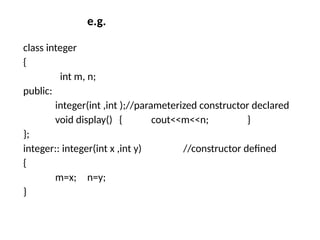OOP unit II inheritance.pptx object oriented programming
- 1. Unit II Inheritance and Pointers Inheritance
- 2. • Reusability is yet another feature of OOP. • C++ strongly supports the concept of reusability. • The mechanism of deriving a new class from an old one is called 'INHERITANCE'. • The old class is called 'BASE' class and the new class is called 'DERIEVED‘ class.
- 3. Defining Derived Classes • A derived class is specified by defining its relationship with the base class in addition to its own details. • Syntax: class derived-class-name: visibility-mode base-class-name { ….. …..//members of derived class }
- 4. class XYZ //base class { members of XYZ }; class ABC : public XYZ //public derivation { members of ABC }; class ABC : XYZ //private derivation (by default) { members of ABC };
- 5. • In the inheritance, some of the base class data members and member functions are inherited into the derived class. • We can add our own data members and member functions and thus extend the functionality of the base class.
- 6. • When a class inherits from a single base class, it is known as single inheritance. • Following program shows the single inheritance using public derivation.
- 7. #include<iostream> using namespace std; class B{ int a; //private, not inheritable public : //public, ready for inheritance int b; void get_ab(); int get_a(); void show_a(); }; Class D : public B{ int c; public: void mul(); void display(); };
- 8. void B :: get_ab(){ a=5; b=10; } int B :: get_a() { return a ; } void B :: show_a() { cout<< “a=“ << a << “n” ; } void D :: mul() { c = b * get_a(); } void D :: display() { cout << “a=“ << get_a() << “n”; cout << “b=“ << b << “n”; cout << “c=“ << c << “nn”; } int main() { D d; d.get_ab(); d.mul(); d.show_a(); d.display();
- 10. program for single inheritance using private derivation.
- 11. #include<iostream> using namespace std; class B{ int a; //private, not inheritable public : //public, ready for inheritance int b; void get_ab(); int get_a(); void show_a(); }; Class D : private B{ int c; public: void mul(); void display(); };
- 12. void B :: get_ab() { a=5; b=10; } int B :: get_a() { return a ; } void B :: show_a() { cout<< “a=“ << a << “n” ; } void D :: mul() { get_ab(); c = b * get_a(); } void D :: display() { show_a(); cout << “b=“ << b << “n”; cout << “c=“ << c << “nn”; } int main() { D d; //d.get_ab(); won’t work d.mul(); //d.show_a(); won’t work d.display();
- 13. //d.b=20; won’t work ,b has become private d.mul(); d.display(); return 0; }
- 14. MULTILEVEL INHERITANCE e.g. #include<iostream.h> class student { protected: int rn; public: void getn(int a) { rn=a ; } void putn(int a) { cout<<“roll no is”<<rn; } };
- 15. class test : public student //1st level derivation { protected: float s1,s2; public: void getm(float x,float y) { s1=x; s2=y; } void putm() { cout<<“marks in 2 subject are “<<s1<<s2; } };
- 16. class result : public test { //2nd level derivation float total; public: void display() { total=s1+s2; putn(); putm(); cout<<“total=“<<total; } int main(){ result stud1; stud1.getn(101); stud1.getm(75.0,59.5); stud1.display(); return 0;}
- 17. Multiple inheritance class M{ protected: int m; public: void getm(int x){m=x; } }; class N{ protected: int n; public: void getn(int y){ n=y; } }; class P:public M,public N{ public: void display() { cout<<m<<n<<m*n; } };
- 19. Ambiguity resolution in inheritance class M{ public: void display() { cout<<”class M”; }}; class N{ public: void display() { cout<<”class N”;}}; class P:public M,public N{ public: void display() //overrides display of M and N { M::display(); } };
- 20. int main(){ P p; p.display(); return 0; }
- 21. virtual base class class A{ ..... }; //grand parent class B1:virtual public A //parent 1 { ...........}; class B2: public virtual A //parent 2 { ...........}; class C: public B1,public B2 //child { ........... //only 1 copy of A will be inherited };
- 25. Constructor • Special member function to initialize objects of its class. • It has same name as that of the class. • It constructs the values of data members of the class.
- 26. Class with a default Constructor(no parameters) class integer { int m,n; public: integer(); //constructor declared ……. }; Integer:: integer() //constructor defined { m=0; n=0; } In main() integer int1; //object int1 created
- 27. Parameterized Constructor(with parameters) class integer{ int m, n; public: integer(int x,int y); //parameterized constructor declared ……. }; Integer:: integer() //constructor defined { m=x; n=y; } In main() integer int1(10,20); //object int1 created by implicit call OR Integer int1=integer(10,20); //object int1 created by explicit call
- 28. e.g. class integer { int m, n; public: integer(int ,int );//parameterized constructor declared void display() { cout<<m<<n; } }; integer:: integer(int x ,int y) //constructor defined { m=x; n=y; }
- 29. int main(){ integer int1(10,20); //constructor called implicitly integer int2=integer(100,200); // constructor called explicitly cout<<“OBJECT1”<<endl; int1.display(); cout<<“OBJECT2”<<endl; int2.display(); return 0; }
- 30. constructors in derived class class A{ int x; public : A(int i) { x=i; cout<<”A initialized”; } void showx() { cout<<x; } }; class B{ float y; public: B(float j) { y=j; cout<<”B initialized”; } void showy() { cout<<y; } };
- 31. class C:public B,public A { int m,n; public : C(int a,float b,int c,int d):A(a),B(b){ m=c; n=d; cout<<”C initialized”; } void showmn(){ cout<<m<<n; } };
































